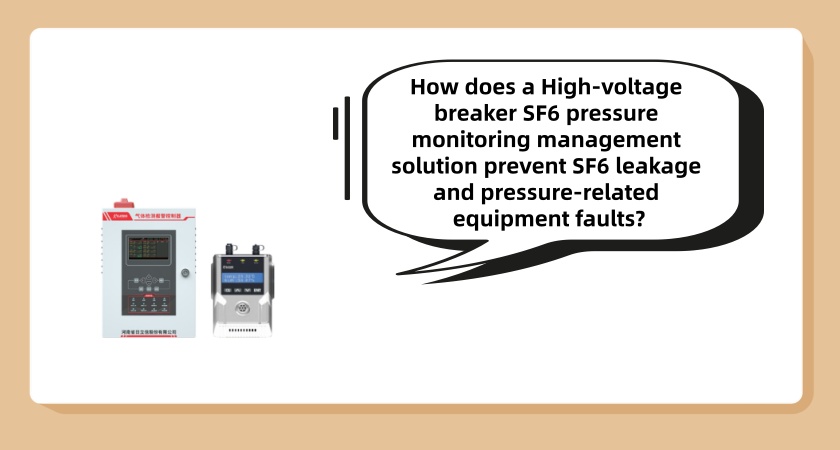
How does a High-voltage breaker SF6 pressure monitoring management solution prevent SF6 leakage and pressure-related equipment faults?
1. Introduction: Why SF6 pressure monitoring matters for high-voltage breakers
High-voltage breakers are critical components in power grids, responsible for interrupting fault currents and maintaining system stability. Most modern high-voltage breakers use sulfur hexafluoride (SF6) as an insulating and arc-quenching medium—its excellent electrical insulation and heat dissipation properties make it irreplaceable in high-voltage scenarios. However, SF6 is a potent greenhouse gas, and leaks or pressure drops in breakers can lead to two major risks:
Reduced insulation performance, increasing the chance of equipment breakdown or even grid outages;
SF6 emissions that violate environmental regulations (e.g., the EU’s F-Gas Regulation).
This is where a reliable High-voltage breaker SF6 pressure monitoring management solution becomes essential. It not only prevents equipment failures but also supports green power operation by minimizing SF6 leakage.
2. Core components of the High-voltage breaker SF6 pressure monitoring management solution
A mature solution integrates hardware, software, and Operation and Maintenance (O&M) protocols to achieve full-cycle monitoring and management.
2.1 High-precision hardware: The foundation of accurate monitoring
SF6 pressure sensors: Select sensors with a measurement range of 0–1.5 MPa (matching typical high-voltage breaker SF6 pressure levels) and an accuracy of ±0.1% FS. They must withstand harsh substation environments (temperature: -40°C to 85°C, humidity: 0–95% RH) and resist electromagnetic interference (EMI). Wireless sensors (e.g., LoRa or 4G-enabled) are preferred for easy installation in remote substations, while wired sensors (RS485/Modbus) suit indoor facilities.
Data acquisition modules: Collect real-time pressure data from sensors and transmit it to a central platform. Modules should support edge computing to filter noise and reduce data transmission latency—critical for real-time fault response.
On-site alarm units: Equipped with audible and visual alarms (red LED + 85dB buzzer) to alert on-site staff when pressure exceeds pre-set thresholds (e.g., 10% below the rated pressure).
2.2 Intelligent software platform: The brain of management
The software layer transforms raw data into actionable insights, with key functions including:
Real-time monitoring dashboard: Visualize SF6 pressure, temperature, and leakage status of each breaker (via charts or maps). Users can quickly locate abnormal equipment (e.g., a breaker with pressure dropping 5% in 24 hours).
Data storage and analysis: Store historical data (for 1–3 years) on a cloud or local server, enabling trend analysis. For example, the system can predict pressure decay rates and recommend maintenance before faults occur (predictive maintenance).
Remote alert and notification: Send SMS/email alerts to O&M teams when pressure is abnormal or sensors fail. The platform also supports mobile access (via apps), allowing engineers to monitor status anytime, anywhere.
Compliance reporting: Automatically generate SF6 emission and pressure logs to meet regulatory requirements (e.g., annual F-Gas reports for EU clients).
2.3 Standardized O&M protocols: Ensure long-term reliability
A solution is only effective with proper operation and maintenance. Key protocols include:
Regular sensor calibration: Calibrate pressure sensors every 12 months (using a standard pressure source) to ensure accuracy—drifted sensors can lead to false alarms or missed faults.
Leakage detection: Use SF6 leak detectors (detection limit: ≤1×10⁻⁶ mL/s) to inspect breaker seals and valves quarterly. If a leak is found, isolate the breaker and replenish SF6 (using recycled gas to reduce emissions).
Emergency response plan: Define steps for pressure plummet (e.g., switch to a backup breaker within 5 minutes to avoid grid downtime) and assign clear responsibilities to O&M teams.
3. Benefits of implementing the solution
Improved equipment safety: Reduce high-voltage breaker failure rates by 60%+ by preventing insulation breakdown caused by low SF6 pressure.
Environmental compliance: Minimize SF6 emissions by 80% through early leakage detection and recycled gas use, aligning with global carbon neutrality goals.
Lower O&M costs: Replace reactive maintenance (repairing after failures) with predictive maintenance, cutting downtime costs by 40% and extending breaker service life by 5–8 years.
Smart grid integration: The solution’s data can be connected to a grid’s SCADA system, supporting overall grid Intelligentization (e.g., load adjustment based on breaker status).
4. Conclusion
As power grids become more complex and environmental regulations stricter, a High-voltage breaker SF6 pressure monitoring management solution is no longer an option but a necessity. By combining high-precision hardware, intelligent software, and standardized Operation and Maintenance,it ensures high-voltage breakers operate safely, efficiently, and sustainably. When selecting a solution, prioritize compatibility with existing grid equipment, vendor after-sales support (e.g., 24/7 technical service), and compliance with international standards (e.g., IEC 62271-203 for SF6 equipment).

Leave A Message
Your email address will not be published. Required fields are marked *